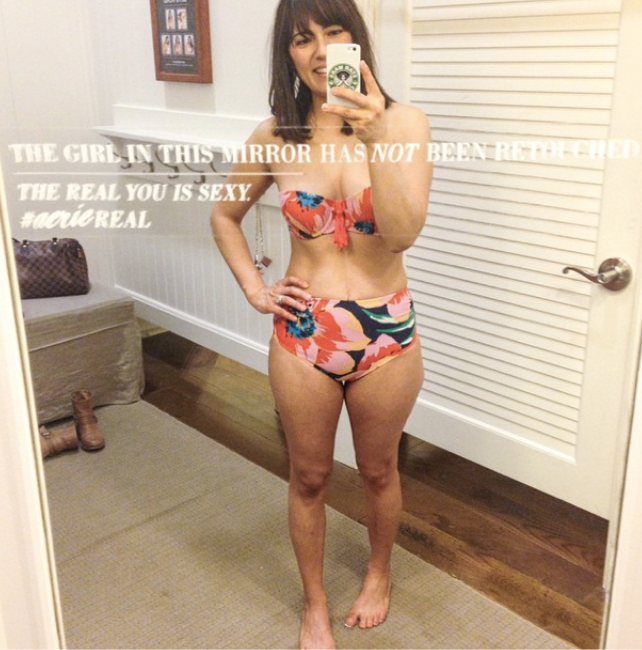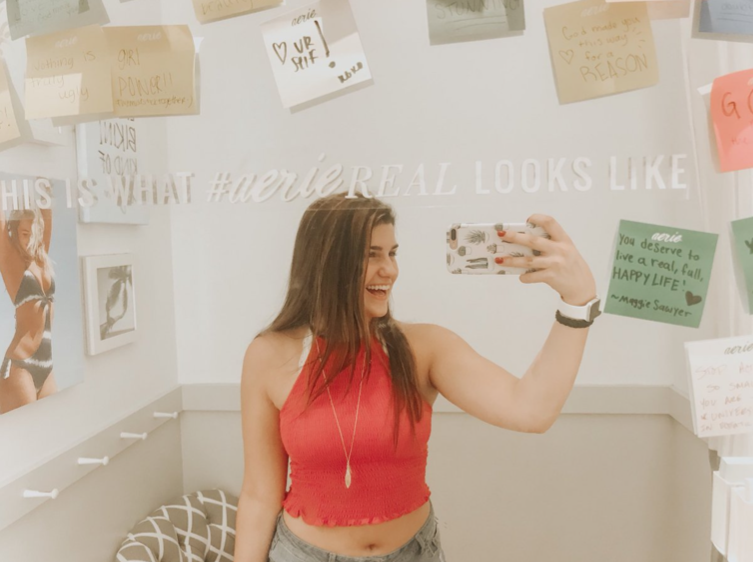Body-Positive Branding: Function over Fashion?
“How do I look?” my roommate asks, turning in slow circles in front of our full-length mirror.
“How do you feel?” I respond.
“That’s not what I asked.”
It was a knee-jerk response, one hammered into my muscle memory after one summer working at Aerie, American Eagle’s lingerie- and loungewear-focused sub-brand. Founded in 2006, Aerie sought to fill a gap in its parent company’s product range, targeting female consumers aged 15-25. In 2014, the brand launched “#AerieREAL,” a campaign committed to discontinuing their use of photo retouching in product photos and advertisements in an effort to push their new motto: “The real you is sexy.”
Image credit: Aerie
For as long as I can remember, I’ve loved shopping. Not only to have more clothes in my closet, but also for the fantasy aspect — playing dress-up, seeing myself with a dozen new personas and picking one to take home. But like most consumers, I’ve had my fair share of bad shopping experiences. I often blamed myself when I left a store empty-handed, insecure or even offended. It wasn’t until I began working retail that I understood what truly separated the good from the bad.
At Aerie, our aim was not to sell clothes, but to make people feel good. Brand loyalty mattered more than sales; if a shopper had a good experience, even if they didn’t make a purchase, they were more likely to come back and try again. This was accomplished subliminally — the AerieREAL way subtly pervaded every part of the store environment, for both customers and employees. Interactions were curated down to individual word choice. Customers were referred to as “guests.” If grabbing a product for a guest, we were trained to ask, “What size do you feel most comfortable in?” as opposed to “What size do you wear?” If they asked us how they looked, we flipped the question back on them: “How do you feel?”
Image credit: Aerie
I can see how this would be frustrating for customers who just want an honest second opinion. But at Aerie, it wasn’t our job to provide that. I have complicated views on Aerie’s employee script. Yes, it helped employees side-step potentially sensitive conversations about body image in a store that pushed body positivity. But I also saw it as a way for the brand to avoid liability — if a customer was unsatisfied with the clothes or with their experience, it could only be attributed to the customer’s own opinion and not an off-hand comment made by a sales associate (or as we called them, brand ambassador — yet another example of Aerie’s prioritization of pushing the brand over selling merchandise). The mentality was that this kept customers coming back, possibly thinking, “I didn’t find anything I liked, but the employees were so nice to me. Maybe I’ll come back another day.”
The AerieREAL strategy was practiced to be applied to every interaction with guests. One instance occurred during training, when we tried on every legging style in order to build product knowledge. As I slipped on the third of five pairs in the Aerie fitting room, I overheard one of my managers giving advice to the brand ambassador next door.
“I had a guest who was between sizes ask if she should size up or down. I asked her, ‘What do you plan on doing in them?’ If she says she wants to lounge, tell her size up. If she’s gonna work out, tell her size down.”
It was then that I realized the key to Aerie’s approach to body-positive branding: function over form. Although we sold clothes in bright colors and fun patterns for customers to spice up their look, the company treated clothes as utilitarian objects. It wasn’t about how you wanted to look — it was about what purpose the clothes served in your routine. To a certain extent, clothes are meant for utility. But for those who see clothing as decoration, the AerieREAL method feels more like a way to dodge important questions that inform a purchase, questions like “Which color looks best with my skin tone?” or “Which cut is more flattering?” Aerie’s strategy works best in situations when the customer purchases clothes only for personal enjoyment, which isn’t always the case. Many buy and wear clothes with an acute awareness that they’ll be perceived by others, and aim to pick the clothing that will produce the best possible perception. By refusing to answer customers who ask for an idea of that perception, we leave a crucial purchasing criteria ambiguous.
Image credit: Carmel Phillips, Our Fifth House Image credit: Maggie Sawyer, @avennmusic on Twitter
For a brand that claims to value body positivity above all else, Aerie uses selling strategies that seem to reflect body neutrality, an acceptance of the body for its functions and capabilities as opposed to its appearance. I wasn’t the only one who took note of this disconnect; a manager expressed the same sentiment to me without me ever verbalizing my thoughts. By selling clothes as functional items we were pushing the narrative that you don’t need to decorate your body in an effort to feel one way or the other about it. We asked guests how they felt in an effort to prompt them to see their bodies how they wanted to see them, instead of simply pushing an always-positive view.
Maybe it’s time for a new take: Does the real you have to be “sexy,” or can it just be…you?





